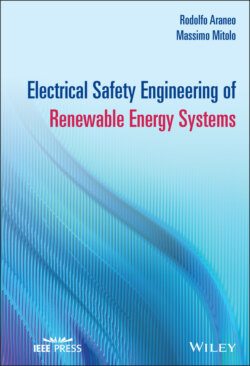Читать книгу Electrical Safety Engineering of Renewable Energy Systems - Rodolfo Araneo - Страница 18
1.4 Thermal Shock
ОглавлениеThe current i passing through the human body during the contact time t with an energized part produces a physiological damage due to the generation and transfer of heat, per the Joule effect, to the biological tissues. An electric burn is defined as the burning of the skin or of an organ caused by the flow of an electric current along its surface or through it. Electric burn injuries account for 4% to 6% of all admissions to burn-care facilities [18].
The amount of heat generated in the tissue depends on the current density and the tissue conductivity. However, the conductivity is in turn determined by the heat generated in the tissue; since the tissue ionic conductivity increases with the increasing temperature, a further intensification in current density and temperature occurs. Thus, the thermal injury is determined as the result of a feedback mechanism; however, the conductivity change is not considered in burn models due to the complexity of the resulting nonlinear equations.
w delivered by a current i during the time t to a homogeneous volume of biological tissue of length l, cross-sectional area and ionic conductivity σ (Eq. 1.2), it is conservatively assumed an adiabatic process. Such a process calls for no heat removal into neighboring tissues by blood flow or by conduction and/or convection into the air, but it is presumed that all the heat stays within the tissue.
(1.2)
Vues of ionic conductivity of some biological tissues are listed in Table 1.3 [12].
Table 1.3 Electrical conductivity σ of biological tissues
| Tissue | σ (S/m) |
|---|---|
| Blood | 7.00E-1 |
| Bone | 8.07E-2 |
| Cartilage | 1.71E-1 |
| Fat | 4.04E-2 |
| Heart | 8.27E-2 |
| Kidney | 8.92E-2 |
| Muscle | 2.33E-1 |
| Nerve | 2.74E-2 |
| Skin (dry) | 2.00E-4 |
| Skin (wet) | 4.27E-4 |
The thermal injury will depend on the duration t of the contact and the temperature rise ΔT that the passing current will impose [19]. The thermal energy expressed in Eq. 1.2 is related to the temperature rise ΔT to which the volume of tissue is subjected. We can write the thermal balance equation (Eq. 1.3), which describes the exchange of heat between the heat delivered w and the heat accumulated in the volume of tissue, assuming σ independent of the temperature.
(1.3)
c is the volume-specific heat capacity, defined as the heat necessary to increase the temperature of a unit volume of a substance by 1˚C.
The temperature rise ΔT is given by Eq. 1.4
(1.4)
Equation 1.4 shows that the temperature rise ΔT depends on the square of the current density J and on the duration t of the current circulation.
The skin has the lowest conductivity among the biological tissues, and the current density is higher at the point of contacts on the body (referred to as entry and exit sites); therefore, for a given current, the highest temperature rise is achieved on the skin, which therefore suffers the greatest level of damage.
Thermal injury of the human skin occurs when the temperature rise persists for a sufficient length of time: for instance, to cause cutaneous injury, a temperature of the skin of 45°C requires a contact duration of 2 h; 51°C requires a contact duration of 2 min; and 60°C requires a contact duration of 3 s4 Current densities of a few mA/mm2 for a duration of about 0.5 to 1 s can cause burns, whereas a current density of a few tens of mA/mm2 for a few seconds, will cause third-degree burns with destruction of deeper tissues and possible necrosis.
Thermal shock can also be caused by the heat released by electric arcs, which are accompanied by the vaporization of metal to form a superheated toxic gas.
